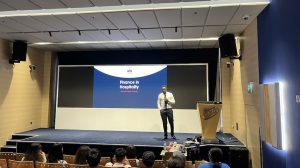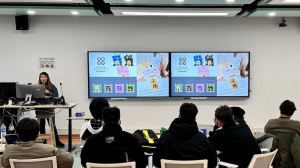The latest chatbot technology should not be a worry to those teaching English as a foreign language, suggests IFTM Lecturer Mr. Wilson Hong. Tools such as ChatGPT will in likelihood become part of educational-content development, and offer opportunities to rethink foreign-language teaching and study
ChatGPT, a revolutionary artificial intelligence-powered language model, has sparked concerns in the educational field, but the chatbot technology offers “major opportunities” for teachers and education institutes to improve second-language and foreign-language teaching and assessment. That is according to an academic paper by IFTM Lecturer Mr. Wilson Hong Cheong Hin.
The paper – “The impact of ChatGPT on foreign language teaching and learning: Opportunities in education and research” – was published earlier this year in the Journal of Educational Technology and Innovation (click here for details).
With ChatGPT being an “inevitable” development, “teachers and education institutes should take it as an opportunity to innovate the century-old methods of teaching and assessment,” Mr. Hong writes.
He teaches courses at IFTM related to English as a foreign language. His teaching experience includes periods spent overseas, and he has worked with students of various ages and nationalities. Mr. Hong is president of the Macao Education Development Research Association and an executive board member for the Macao Association of Psychological Health.
The IFTM scholar identifies in his paper an array of benefits and opportunities in education linked to the use of chatbot technology. One example is that it provides students of English as a foreign language with more opportunities for “authentic” language use.
“In places that are very much exam-driven, such as Macao, learners are only given artificial language [exercises] that do not correspond to the daily usage of the foreign language”, suggests Mr. Hong. But as ChatGPT “excels in mimicking human interactions, learners can easily initiate authentic conversations with the chatbot,” he adds.
Another potential use of ChatGPT in the field of education is as a ‘personal language tutor’, says Mr. Hong. The chatbot technology is able to “pinpoint language and organisational issues in students’ writing, offer writing ideas and suggest corrections”, as well as having the capability to “explain the use of vocabulary in great detail and offer examples.” Best of all, adds the IFTM scholar, “the feedback is instant”.
Mr. Hong says in his paper that the emergence of ChatGPT and similar tools creates an argument against having high volumes of traditional “take-home writing assessments”. The availability to students of technology-powered writing tools undermines the “validity and integrity” of many of these sorts of traditional assignment, he states. Instead, schools should ask students to do assessment tasks “that cannot be easily assisted by artificial intelligence chatbots”, and things that directly and actively engage the students.
Mr. Hong adds that while the application of technology should “not be discouraged”, it is necessary for it actually to be integrated within assignments, as this is how students “would most likely apply the language” they are seeking to learn, later “in real life”.
The IFTM scholar nonetheless highlights that, “in spite of its extremely powerful capabilities, ChatGPT is far from the cognition and language production of human beings as we know them”.
People using the chatbot technology should understand it is “a cutting-edge text-generating search engine” that “is good at mimicking human interactions”. However, it “does not respond to users’ questions by means of reasoning, nor does it respond with emotions, but it compares existing data to draw the most likely – e.g., the most frequent and relevant – responses”.









